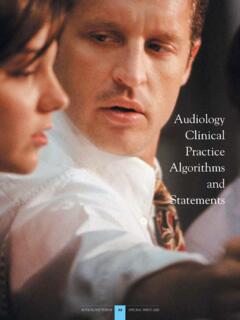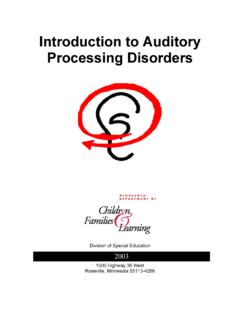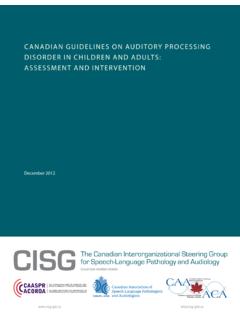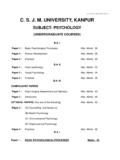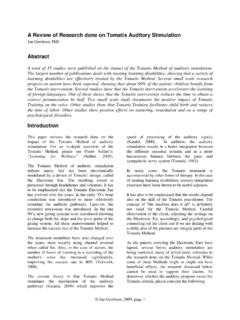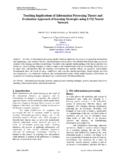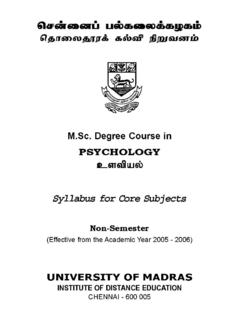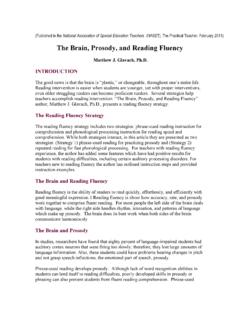Transcription of American Academy of Audiology Clinical Practice …
1 Academy of Audiology Clinical Practice Guidelines diagnosis , treatment and management of Children and Adults with Central auditory processing DisorderAugust 2010 American Academy of Audiology Clinical Practice Guidelines: diagnosis , treatment and management of Children and Adults with Central auditory processing Disorder. 8/24/2010 American Academy of Audiology Clinical Practice GuidelinesGuidelines for the diagnosis , treatment and management of Children and Adults with Central auditory processing DisorderTask Force MembersFrank E. Musiek, (Chair), Professor & Director of auditory Research, Department of Communication Sciences, Professor, Otolaryngology (School of Medicine), University of Connecticut, Storrs, CT 06269 Jane A. Baran, , Professor and Chair, Department of Communication Disorders, School of Public Health and Health Sciences, University of Massachusetts Amherst, Amherst, MA 01003-9296 Teri James Bellis, , Professor and Chair, Department of Communication Sciences and Disorders, Director, USD Speech-Language-Hearing Clinics, The University of South Dakota, Vermillion, SD 57069 Gail D.
2 Chermak, , Professor and Chair, Department of Speech and Hearing Sci-ences, Washington State University, Pullman, WA W. Hall III, , Clinical Professor, Department of Communicative Disorders, College of Public Health and Health Professions, University of Florida, Gainesville, Florida 32611 Robert W. Keith, , Professor, University of Cincinnati - College of Allied Health Sciences Department of Communications Sciences and Disorders Cincinnati, Ohio 45267-0379 Larry Medwetsky, , Vice President, Clinical Services, Rochester Hearing and Speech Center, Rochester, NY 14620 Kathleen Loftus West, , Coordinator of Audiology Services, Children s Hospital Boston at Lexington, Lexington, MA 02420 Maxine Young, , Private Practice , Broomall, PA 19008, Adjunct Instructor, Salus University, George Osborne School of Audiology , Elkins Park PA 19027 Stephanie Nagle, , Student Volunteer, University of Connecticut, Storrs, CT 06269 American Academy of Audiology Clinical Practice Guidelines.
3 diagnosis , treatment and management of Children and Adults with Central auditory processing Disorder. 8/24/20103 EXECUTIVE SUMMARYThe following Clinical Practice guidelines provide evidence-based recommendations for the diagnosis , treatment , and management of children and adults with (central) auditory processing disorder ([C])APD). The American Academy of Audiology (AAA) appointed a task force to develop a document to provide direction to clinicians involved in this Practice area, as well as to provide a resource to the AAA and its membership for communication with the public. This document was to build on and expand prior statements and reports on (C)APD issued by other professional associations ( , ASHA, 2005b) and consensus panels ( , Jerger & Musiek, 2000). The present guidelines focus on four major areas of (C)APD: 1) patient history and selection criteria, 2) diagnosis , 3) intervention, and 4) professional issues, education, and training.
4 The guidelines emphasize the following points and contain the following recommendations.(C)APD is seen in a wide array of populations, including children and adults. It can be the result of a number of different etiologies that involve deficits in the function of the central auditory nervous system (CANS). Neurological involvement ranging from degenerative diseases to exposure to neurotoxic substances can result in (C)APD. In addition, develop-mental, communicative, and learning-related problems, as well as peripheral hearing loss and aging processes, can impact central auditory processing . A substantial number of individuals seen for (C)APD evaluations are children and adults with disorders of auditory processing due to diffuse central nervous system (CNS) dysfunction but with no identifi-able lesions.
5 These individuals often have difficulties with language, learning, and reading in addition to their auditory deficits. In questioning the patient or informant, it is essential that the clinician consider a range of issues, including hearing, medical, educational, social, developmental, and communicative status. A comprehensive history often reveals potential comorbid conditions that may affect test performance and the interpretation of the test results. It also ensures the selection of diagnostic tests most appropriate to the individual s profile and most likely to provide valid and reliable information leading to accurate diagnosis . Patient factors and considerations include: age, cognitive ability, general behavior, speech, language and hearing status, motivation, and attention issues.
6 An in-depth, relevant history and care-ful test selection process will maximize the power of the diagnostic test purposes of central auditory testing are two-fold: (1) to identify the presence of abnormalities in or dysfunction of the CANS and diagnose (C)APD, and (2)to describe the nature and extent of the disorder for purposes of developing management and intervention programs for affected individuals. Accurate diagnosis is dependent on the administration and interpretation of sensitive, efficient, and well-normed behavioral and electrophysiologic measures of central auditory function. Given the complexity and redundancy of the central auditory system, accurate diagnosis typically requires the administration of more than one test; however, while sensitivity may be improved by increasing the number of tests in the battery, the administration of too many central auditory tests may compromise specificity.
7 The clinician should select normed tests that provide insights regarding the presence of (C)APD, assessment of various central auditory processes and behaviors, and evaluation of the integrity of the CANS at multiple sites and levels. Tests that have been shown to be sensitive and specific to known involvement of the CANS ( , through lesion studies, brain imaging, and other methods) provide guidance regarding the integrity of the various auditory processes and the CANS. Tests should be selected that have appropriate normative data. No matter how efficient a test may prove to be, it is of no Clinical utility if appropriate norms are not for (C)APD has received much attention recently due to advances in neuroscience demonstrating the key role of auditory plasticity in producing behavioral change through intensive training.
8 With the documented potential of a variety of auditory training procedures to enhance auditory processes, the opportunity now exists to change the brain, and in turn, the individual s auditory behavior through a variety of multidisciplinary approaches that target specific auditory deficits. Customizing therapy to meet the client s profile ( , age, cognition, language, intellectual capacity, comorbid conditions) and functional deficits typically involves a combination of bottom-up and top-down approaches. American Academy of Audiology Clinical Practice Guidelines: diagnosis , treatment and management of Children and Adults with Central auditory processing Disorder. 8/24/20104In addition to auditory training, the management of acoustic conditions ( , classroom acoustics) and signals ( , through high fidelity listening devices), coupled with educational, cognitive, language, metacognitive, and metalinguistic strategies can serve to reduce auditory deficits and lead to more effective listening, communication, and there has been significant progress in professional education and training in (C)APD, as evidenced by the increas-ing number of conference presentations, published articles, and professional association reports on this topic, there remains a documented need for additional improvements in this area at the graduate education level and through con-tinuing education.
9 In particular, additional course work in the basic sciences will provide clinicians with the knowledge needed to critically apply diagnostic tools and treatment the most pressing professional issues is the lack of intensive treatment provided in schools. Ironically, although large numbers of individuals with (C)APD are children in schools, current school policies and caseloads do not support the intensive training required for cortical reorganization and behavioral change. Because (C)APD is often a multifaceted problem, a team approach is needed to best serve the individual and his/her family. (C)APD must be diagnosed by an audiologist; however, other professionals can and should be involved in the broad assessment of the functional deficits experienced by the individual with (C)APD and in planning the intervention activities needed to minimize those deficits.
10 Reimbursement is another pressing professional issue. Despite improved reimbursement rates for some diagnostic services, the rates remain inadequate, and clinicians cannot use some current procedural terminology (CPT) codes with certain third party payers ( , Medicare) to secure reimbursement for their intervention efforts. The AAA and other pro-fessional associations representing audiologists must continue their efforts to educate physicians, teachers, parents, and legislators and their staffers to the level of education, training, instrumentation, and Clinical time needed for the accurate and early diagnosis and multidisciplinary assessment of (CAPD) and its intervention. The support and advocacy of these professional associations may lead to smaller caseloads and more therapy time per child in schools, as well as positive changes in reimbursement guidelines are not exhaustive and are not intended to serve as the sole source of guidance for the clinician, nor are they intended to replace Clinical judgment.

